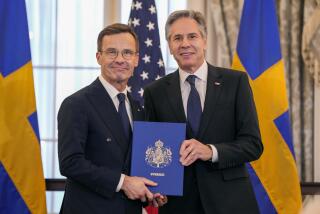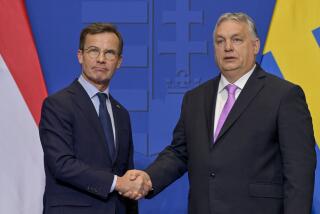ANALYSIS / THE NORDIC CONNECTION : Loath to Anger Soviets, Scandinavians Adopt Go-Slow Policy Toward Baltics
- Share via
WASHINGTON — The Baltic Sea had no Homer to chronicle its ancient wars and tempests. In modern times, it is often dismissed as the backwater of Northern Europe. But historic dramas on the Continent have always washed up on its shores, and with fateful consequences.
Today, the political and economic convulsions shaking the Soviet Union have provided an opportunity for Lithuania, one of the three Baltic states absorbed by the Soviets in 1940, to declare its independence. The outcome could set a precedent for the two other Baltic republics, Estonia and Latvia, and perhaps for other Soviet republics as well.
Both are moving more cautiously. Latvia this month declared its independence but promised a “transition period” of unspecified length before its own laws would take effect. Estonia changed its name from Soviet Socialist Republic to simply the Republic of Estonia and removed the hammer and sickle from its flag.
Whether the Baltics succeed will be determined in large measure by the degree of support and encouragement they get from the Scandinavian nations, Denmark, Norway, Sweden and Finland.
In all the world, the Baltic republics have no greater sympathizers than the Nordic states. For a millennium, by means of conquest, trade and migration, the Nordic states have shared their culture and destiny with the Baltic region.
Experts contemplating the future of Europe have talked about a confederation of the Nordic states and elements of the Hanseatic League, which flourished in the Middle Ages. Among its components were the Baltic states and a number of city-states along the Baltic coasts of what are now Poland and Germany.
Yet the Nordic states have offered little support for Lithuania in its present dispute with Moscow. Like the United States and the European Community, they have not recognized the legitimacy of Lithuania’s March 11 declaration of independence.
Particularly striking was the failure of a recent Nordic emergency meeting to agree on a statement that might have noted Lithuania’s “return to sovereignty” and condemned Moscow’s blockade of Lithuania. The Finns accept the blame.
“We do not see that going at the throat of a superpower is in our self-interest,” Jukka Valtasaari, Finland’s ambassador in Washington, said in an interview.
“And we don’t believe accusing the Soviets will help the situation in Lithuania.”
Finland’s rationale for its Baltic policy is based not just on its well-founded fear of the Russian bear. The Finns are also signaling that they favor Estonia’s gradual approach to sovereignty--economic autonomy first and political independence later--over Lithuania’s headlong plunge into confrontation.
Like Finland, the other Nordic countries claim a special relationship with the Baltic. But they, too, are reluctant to take on the Soviet Union directly.
Denmark forcibly Christianized and colonized the Baltic region in the 12th Century, and Danish children are still taught the legends of that period.
The Danes championed the Lithuanian cause in the European Community, but they have declined to go beyond a collective statement complaining of the “coercive nature” of the Soviet sanctions.
Sweden also ruled the Baltic region for long periods. After World War II, it took in thousands of Latvian and Estonian refugees, whose children now form strong pro-Baltic interest groups there. It has set aside about $166 million in a special foreign aid program “to meet the needs of Lithuanians when that is possible.” Sweden delivered a diplomatic note to Moscow condemning the blockade.
Norway identifies with the Baltics because the pact between Adolf Hitler and Josef Stalin that delivered the Baltic states to the Soviet Union also gave the Germans a green light to occupy Norway. Norway has also condemned the Soviet economic sanctions.
But none of the Nordic states are as close to the Baltics as Finland. Culturally, the Finns are more closely related to the other Scandinavian nations, but ethnically and linguistically they are more Baltic.
Before World War II, Finland, which retained its independence while the other Baltic states were forcibly annexed by the Soviet Union, was considered one of four Baltic states.
Ambassador Valtasaari said Finland’s policy toward independence for Lithuania, Estonia and Latvia reflects its historical experience as a grand duchy of Czarist Russia from 1807, when the Napoleonic Wars ended six centuries of Swedish rule, until 1917, when Finland achieved its freedom.
“Finland had economic autonomy, including our own currency, for 110 years before we won political independence,” Valtasaari said. “The Estonians have looked at Finnish history, at historical parallels. They are pursuing economic autonomy first, while the Lithuanians are pursuing political independence first.”
More to Read
Sign up for Essential California
The most important California stories and recommendations in your inbox every morning.
You may occasionally receive promotional content from the Los Angeles Times.













